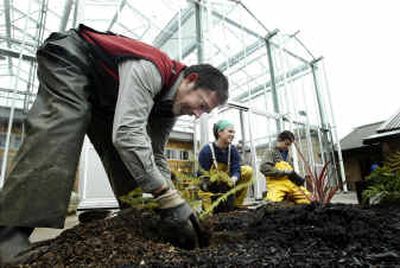UW rebuilds firebombed horticulture center

SEATTLE – When ecoterrorists firebombed the University of Washington’s Center for Urban Horticulture nearly four years ago, they thought they were targeting a researcher who was genetically engineering trees.
They were wrong.
Biology professor Toby Bradshaw was simply studying the genetics of hybrid poplar trees that had been cross-pollinated – a method scientists have used for centuries to unlock basic clues to how plants grow.
The May 21, 2001, fire destroyed his lab and gutted much of Merrill Hall, obliterating decades of work and records for some teachers and causing more than $3 million in damage.
Now the university is ready to open a new $7.2 million building designed to highlight the center’s focus on environmental conservation – with everything from solar panels and a stormwater recycling system to low-flush toilets and furniture made from salvaged city trees.
The center has applied for the U.S. Green Building Council’s seal of approval, known as Leadership in Energy and Environmental Design (or LEED) certification, and expects to get the final say on its rating later this year.
“Three and a half years ago, I thought a ‘green building’ had to be painted green, so we’ve come a long way since then,” Sue Nichol, a spokeswoman for the center, said Tuesday, a day before the building’s scheduled dedication.
It also has a state-of-the-art fire protection system – with sprinklers both inside and outside – and a tighter security system.
Bradshaw won’t be doing his research in the new building. He found a new home for his lab in a biology building across campus soon after the fire, while most of his colleagues have spent the last few years working out of trailers.
Bradshaw said he feels for colleagues who lost so much. He had extra copies of crucial data, and his stocks of DNA and seeds were in refrigerators that suffered minimal smoke and water damage.
“Even though I was the main target, it was little more than a bump in the road for me – which is one of the many ironies surrounding this whole thing,” Bradshaw said.
The Earth Liberation Front, a group that has carried out sabotage against targets it deems to be threats to the environment, claimed responsibility for the fire at the horticulture center. The ELF also said it was responsible for a fire lit the same day at a tree farm in Clatskanie, Ore., that grew hybrid poplar trees – which produce large amounts of wood on a small area of land, for paper-making.
In an anonymous statement, ELF wrote that the attacks were blows against research and industry that it characterized as “an ecological nightmare” to the diversity of native forests.
The FBI is offering a $50,000 reward for information leading to arrests and convictions in both fires. At a preview of the building Tuesday, John Wott, the horticulture center’s acting director, did more bragging about the new building than dwelling on the past.
He showed off a conference room with a table made of polished slabs of ash that might otherwise have been chucked into a landfill. Four gnarled slabs of a taxus yew chopped down as it was dying hung decoratively on one wall.
In a nearby room, Wott pointed to cabinets made of “strawboard” – a plywood-like material made from straw salvaged from sunflower fields in North and South Dakota.
Looking back on the attack, Bradshaw has harsh words for the arsonists who targeted him.
“It’s basically abysmal ignorance of science,” he said. “It’s really sad. With the availability of information today … you have to assume it’s willful ignorance.”